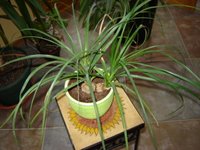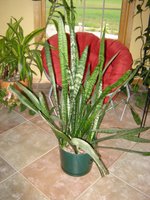ProblemMy philodendron has become nothing more than long vines with very few leaves. What can I do?
AnswerPhilodendron’s need what I like to call “hair cuts” to remain full. If you don’t want to trim your whole plant, do a handful of vines first versus the whole thing. Clip the vines back to a couple of inches from the beginning. Take your clippings and trim them down so they are long enough to fit into a vase filled with water. Continue to provide the clippings with water and within a month or so, your philodendron clippings should begin forming roots. After a good set of roots have formed, you can now replant your clippings with the original plant.
ProblemMy heart-leaf philodendron leaves have developed a white fuzzy substance and have begun dying. I wipe the fuzzy substance off, but it comes right back. The fuzz even shows up on new leaves while they are developing.
AnswerYour Philodendron has gotten infested with mealy bugs or a type of mold. First thing you need to do is move it away from other plants so the infestation don't spread. Try removing the white fuzz with rubbing alcohol on a cotton swab. After a day or so, spray the entire plant with water, like a mist. Do this for a couple days. If the rubbing alcohol doesn't work, go to your local garden center and try a insecticidal soap.
ProblemMy Philodendron plant looks beautiful and healthy, however it won’t grow any larger. What am I doing wrong?
AnswerMany times when a plant looks otherwise healthy, it typically signals a lighting problem. The plant is receiving enough light to remain healthy but not enough to flourish. Try providing the plant with more light. Not necessarily direct light. Move it closer to a window or try a grow light a distance away from the plant for a month and monitor what happens. If you see a large amount of improvement leave the plant within the new light arrangement. If you see some improvement but not much, give the Philodendron a little more light until you find the happy medium.
ProblemI’ve had my Philodendron clippings in water for over 5 weeks and still no roots. How long do I wait? Will it hurt the clippings with roots to sit in the water this long?
AnswerBe patient! Each clipping will act differently. Sometimes they may root within 2 - 3 weeks, sometimes longer. Those that do root faster than the rest will be just fine within the water. I actually have a small vase in which I have 2 clippings that have been in water for over 4 years now.
ProblemWhen should I repot my heart-leafed Philodendron?
AnswerI’m not a plant expert on paper, but from my experience, you won’t need to repot your Philodendron often at all. These houseplants like to be root bound. I’ve had mine for 10 years now. I’ve repotted it once and that was just within the last year. If roots start appearing on the top of the soil, you may want to add more dirt to the top of the pot. If adding dirt is not an option than go ahead and repot into a bigger container.
ProblemHow often should I water my Philodendron?
AnswerThis houseplant doesn’t require heavy water. Typically if you water once every 1 - 2 weeks your Philodendron will grow wonderfully.
ProblemMy plant has become infested with little black bugs. How do I get rid of them?
AnswerSpray the plant with a soapy dishwater mix twice a day for one week. If the bugs are still present, visit your local garden center to find an insecticide that will be more potent. I always like to try the dishwater mist first. It’s been quite effective for getting rid of pests on all my houseplants.
Be sure to read my full guide to Heart Shaped Philodendron Plant Care.



 Problem
Problem




